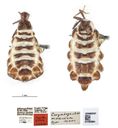Rove Beetles
Staphylinidae
Classification
- Phylum: Arthropoda
- Subphylum: Hexapoda
- Class: Insecta
- Order: Coleoptera
- Suborder: Polyphaga
- Superfamily: Staphylinoidea
- Family: Staphylinidae
Pronunciation
How to pronounce Staphylinidae: //stæfəˈlɪnɪˌdiː//
These audio files are automatically generated. While they are not always 100% accurate, they are a good starting point.
Images






Summary
Rove beetles (Family Staphylinidae) are the largest family of beetles, characterized by their short elytra and predatory habits. With over 66,000 species, these beetles are ecologically diverse and inhabit a wide range of environments, from forest litter to ocean shores. They're known for their predatory behavior and adaptations that allow them to thrive in various habitats, though some can be harmful to humans due to their toxic secretions.
Physical Characteristics
Rove beetles typically measure between 0.7 and 25 mm in body length, with elytra (wing covers) that are short, exposing 3 to 6 abdominal segments, which may be concealed in some species. Body forms are generally elongated but can also be ovoid. Colors vary widely, including yellow, red, brown, black, and iridescent shades. Their antennae usually have 11 segments, and the abdomen may be flexible, allowing some species to fold resembled origami.
Identification Tips
Distinguished from other beetles by their short elytra which usually leave more than half of the abdomen exposed. Some species superficially resemble earwigs, and members of the genus Paederus contain potent toxins.
Habitat
Rove beetles are found in various habitats including forest leaf litter, decaying plant matter, under stones, and along the margins of freshwater bodies. They can also inhabit ocean shores and may live as inquilines within ant and termite colonies.
Distribution
Known globally, with significant representation in temperate and tropical regions. There are approximately 63,650 described species (as of 2018), and estimates of undiscovered species suggest three-quarters may be in tropical regions.
Diet
Most rove beetles are predators of insects and other invertebrates, while a few species are scavengers, carrion feeders, or parasitoids, particularly of fly pupae.
Life Cycle
The life cycle typically involves eggs laid in decaying organic matter or soil. Upon hatching, larvae undergo a series of instars before pupating, with adults emerging to continue the cycle.
Reproduction
Specific reproductive behaviors vary among species, but generally, mating occurs shortly after the emergence of adults. Pairing can involve pheromone signaling and may take place in protective environments such as leaf litter or decaying wood.
Predators
Natural predators of rove beetles include birds and other larger predatory insects. Some beetles have developed potent defenses such as toxic secretions to deter predation.
Ecosystem Role
Rove beetles play a crucial role in ecosystems as predators of other invertebrates and decomposers through their feeding habits, contributing to organic matter breakdown and nutrient cycling.
Economic Impact
Some rove beetles are considered beneficial for biological control of pest populations. However, the potential for greater success in pest management has not been widely realized in experimental applications.
Health Concerns
Certain species, like those in the genus Paederus, can cause chemical burns to the skin through contact with their toxins, leading to a condition known as Paederus dermatitis.
Collecting Methods
- Netting
- Pitfall traps
- Hand collection under debris and stones
- Light traps
Preservation Methods
- Ethanol preservation
- Pinning
- Drying and mounting on labels
Evolution
The Staphylinidae family is an ancient group of beetles with fossil records dating back to the Triassic period, approximately 200 million years ago. Their evolutionary history suggests ongoing diversification, with significant morphological and ecological adaptations observed across numerous subfamilies and tribes.
Misconceptions
Misunderstandings often arise regarding the potential danger of rove beetles; while some species contain toxins, many are harmless and play beneficial roles in ecosystems.
Tags
- Rove Beetles
- Beetles
- Staphylinidae
- Predatory Insects
- Ecological Indicators